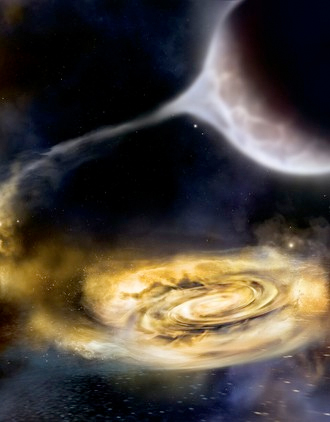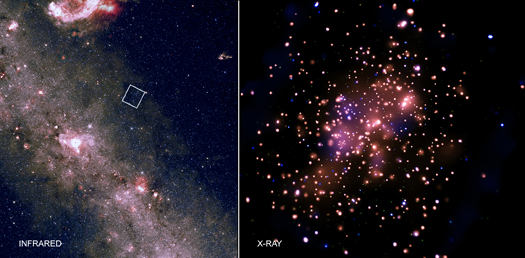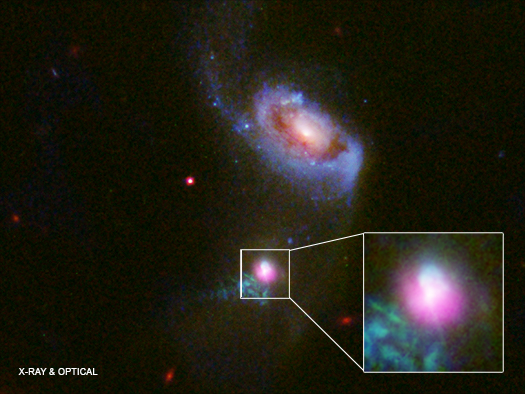Black Holes
Sagittarius A* Swarm: Black Hole Bounty Captured in the Milky Way Center
In some ways, star clusters are like giant families with thousands of stellar siblings. These stars come from the same origins – a common cloud of gas and dust – and are bound to one another by gravity. Astronomers think that our Sun was born in a star cluster about 4.6 billion years ago that quickly dispersed.
The Billion-year Race Between Black Holes and Galaxies: Mar Mezcua

Mar Mezcua
Mar Mezcua is a postdoctoral researcher at the Institute of Space Sciences, in Barcelona (Spain), where she is from. She is a guest blogger today and the leading author of one of the two papers highlighted in our latest press release. aShe conducted this work last year with Prof. Julie Hlavacek Larrondo while at the University of Montreal (Canada).
Supermassive black holes (SMBHs) started to fascinate me when I was 13 years old. These monsters reside at the center of massive galaxies and are the most energetic sources in the Universe. When they are actively accreting, the surrounding matter that feeds them (or that the black hole accretes) can radiate over a trillion times as much energy as the Sun, being able even to outshine the galaxy in which they reside. This feeding, or accreted, material emits X-ray radiation that we can detect with X-ray satellites such as Chandra, while the material that is ejected from the SMBH in the form of jets also often emit at radio wavelengths. (Yes, SMBHs do not only swallow but also emit outflows of energetic particles!) It is for all the above that I pursued a career in astrophysics in order to study these powerful behemoths in detail.
My first close approach took place during my PhD, when I estimated the black holes (BH) masses of a sample of SMBHs whose radio jets had a peculiar morphology. To do this, I used the close relationships that had been recently found between the mass of SMBHs and some of their host galaxy properties, such as how much light was emitted by the central bulge or how quickly and where the stars in the bulge moved.
The finding of such correlations suggested that SMBHs and their host galaxies grow in tandem — that there is a co-evolution — implying that SMBHs somehow regulate the growth of the galaxy in which they reside. As simple as it might sound, this was an astonishing discovery of the late 90’s. SMBHs typically have masses of between one million and one billion times that of the Sun and sizes similar to that of the Solar System, this is, nearly 10,000 times smaller than the galaxy that hosts them. That’s a huge difference in size! How is it then possible that such a ‘small’ central SMBH controls the whole budget of a galaxy? SMBHs were getting more and more exciting every time, so after my PhD I kept on studying them using all tools I had available: radio, optical, infrared and X-ray observations!
The Billion-year Race Between Black Holes and Galaxies: Guang Yang

Guang Yang
We welcome Guang Yang, a 4th-year Astronomy graduate student at Penn State, as a guest blogger. Guang led one of the two studies reported in our new press release about the evolution of supermassive black holes and galaxies. Before studying at Penn State, he obtained his astronomy B.S. degree at the University of Science and Technology of China.
Supermassive black holes, with masses over million times that of our sun, sit in the centers of galaxies. The evolution of these black holes and their host galaxies in the past billions of years of cosmic history is still an unsolved mystery. A prevailing idea is that black hole growth is synchronized with host-galaxy growth, i.e., the ratio between black hole and galaxy growth is constant. "What a beautiful theory," I told my advisor Prof. Niel Brandt, and colleagues Dr. Chien-Ting Chen and Dr. Fabio Vito. "But is it true?” I asked. “Has someone proved it?"
We searched large amounts of literature but did not find dedicated works proving the idea, although it is widely quoted in published papers. "Then why not prove it with observations?" said my advisor. "It can be a great thesis topic for you." I was so happy that my thesis topic was settled and I even dreamed about how our data might nicely support the theory.
We painstakingly analyzed a large amount of data in the Chandra Deep Field-South & North and COSMOS surveys. We successfully tracked the black hole and galaxy growth in the distant universe with NASA's Chandra, Hubble, Spitzer, and other observatories. The observations are so deep that we can study the evolution of black holes and their host galaxies 12 billion years in the past, when the Universe was less than 15% of its current age.
Chandra Helps Track Stormy Weather Around Black Holes

Illustration: NASA/Swift/A. Simonnet, Sonoma State Univ.
An international collaboration of scientists, using data from Chandra and other X-ray telescopes over two decades, has shown that the “weather” around some black holes is stormier than previously thought.
The research, which appears in the January 22th issue of the journal Nature and is available on the arXiv, looked at 21 outbursts in X-rays from 12 X-ray binaries, that is, systems where a stellar-mass black hole is in close orbit with a companion star.
Researchers Catch Supermassive Black Hole Burping — Twice
Using data from several telescopes including NASA's Chandra X-ray Observatory, astronomers have caught a supermassive black hole snacking on gas and then "burping" — not once but twice, as described in our latest press release.
This graphic shows the galaxy, called SDSS J1354+1327 (J1354 for short) in a composite image with data from Chandra (purple), and the Hubble Space Telescope (HST; red, green and blue). The inset box contains a close-up view of the central region around J1354's supermassive black hole. A companion galaxy to J1354 is shown to the north. Researchers also used data from the W.M. Keck Observatory atop Mauna Kea, Hawaii and the Apache Point Observatory (APO) in New Mexico for this finding.
Chandra detected a bright, point-like source of X-ray emission from J1354, a telltale sign of the presence of a supermassive black hole millions or billions of times more massive than our sun. The X-rays are produced by gas heated to millions of degrees by the enormous gravitational and magnetic forces near the black hole. Some of this gas will fall into the black hole, while a portion will be expelled in a powerful outflow of high-energy particles.
A Scuba Dive, a (Failed) Ziploc Bag, and a Trip to the Center of the Galaxy

Chris Russell
We welcome this guest post from Christopher Russell of the Pontifical Catholic University in Chile. Dr. Russell was the creator of the new immersive movies that allow viewers to explore the center of the Milky Way in 360 degrees. In this post, Dr. Russell provides the backstory of how he came to make these innovative movies.
I went to a Galactic Center meeting in Australia in July 2016, where I saw an Occulus Rift (a high-end virtual reality, or VR, setup) display by Chi-Kwan Chan (Univ. of Arizona). With the Rift, you plug it into your computer (so much more powerful rendering than available with a phone) and your position actually determines what is rendered. So if you walk left, right, forward, or backward, you are actually walking through the simulation and therefore seeing a different perspective. The thought of visualizing one of these Galactic Center simulations in this fashion was immediately apparent. Then we talked about 360/VR videos; what is required from the goggle side, computer specs, rendering programs, etc.
The day after the meeting, I went snorkeling, and unfortunately the Ziploc bag I put my phone in to keep it waterproof failed. Not one of my brightest ideas, I must say. But when I was looking for a new phone, the one I wanted (Galaxy s7) had two available promotions: get a free 256 GB memory card (useful, but not really fun), or the Samsung Gear VR goggles (definitely fun). I chose the latter, so now I could at least view 360-degree videos in their native format, and so would be able to view one of the Galactic Center if I could figure out how to make it.
Seeing Double: Scientists Find Elusive Giant Black Hole Pairs
This graphic shows two of five new pairs of supermassive black holes recently identified by astronomers using a combination of data from NASA's Chandra X-ray Observatory, the Wide-Field Infrared Sky Explorer Survey (WISE), the ground-based Large Binocular Telescope in Arizona, and the Sloan Digital Sky Survey (SDSS) Mapping Nearby Galaxies at APO (MaNGA) survey. This discovery could help astronomers better understand how giant black holes grow and how they may produce the strongest gravitational wave signals in the Universe, as described in our press release.
Each pair contains two supermassive black holes weighing millions of times the mass of the Sun. These black hole couples formed when two galaxies collided and merged with each other, forcing their supermassive black holes close together. While theoretical models have predicted such giant growing black hole pairings should be relatively abundant, they have been difficult to find.
Arp 299: Galactic Goulash
What would happen if you took two galaxies and mixed them together over millions of years? A new image including data from NASA's X-ray Observatory reveals the cosmic culinary outcome.
Arp 299 is a system located about 140 million light years from Earth. It contains two galaxies that are merging, creating a partially blended mix of stars from each galaxy in the process.
However, this stellar mix is not the only ingredient. New data from Chandra reveals 25 bright X-ray sources sprinkled throughout the Arp 299 concoction. Fourteen of these sources are such strong emitters of X-rays that astronomers categorize them as "ultra-luminous X-ray sources," or ULXs.
These ULXs are found embedded in regions where stars are currently forming at a rapid rate. Most likely, the ULXs are binary systems where a neutron star or black hole is pulling matter away from a companion star that is much more massive than the Sun. These double star systems are called high-mass X-ray binaries.
The Intermittent Growth of the First Supermassive Black Holes

Dr. Edwige Pezzulli
It is a pleasure to welcome Edwige Pezzulli as a guest blogger. Edwige led the black hole study that is the subject of our latest press release. She is a Ph.D. student at the University la Sapienza in Rome (Italy), under the supervision of Raffaella Schneider. During her Ph.D., she spent several months at the Institute d’Astrophysique de Paris (IAP) in France. She has mainly worked on the study of the origin and properties of the first black holes in the Universe.
“As an adult, I’d like to be sent into a black hole!” This is my first memory from childhood on the topic of space.
Since then, I have studied and discovered a lot more about black holes, and yet they still fascinate me in the same way. Considered, for many, the most exotic objects ever discovered, supermassive black holes are the tip of the iceberg of the “dark” side of the Universe. Supermassive black holes are behemoths located in the centers of galaxies and can be among the most luminous sources ever known, from the radiation of surrounding material.
In particular, observations of the Universe’s earliest supermassive black holes, with masses about a billion times that of the Sun, open the door to many questions, especially this one: how did these monsters form in such a short time?
Astronomers find black holes with similar masses in the present-day universe, but these black holes have grown to their enormous size over a much longer period of time – about 13.8 billion years – compared to those that formed about a billion years after the Big Bang. In order to tackle the question of how supermassive black holes formed in the very early Universe, it is imperative to make numerous observations of the light they generate while pulling in, ie accreting, matter as they grow.
Astronomers Pursue Renegade Supermassive Black Hole

CXO J101527.2+625911
Supermassive holes are generally stationary objects, sitting at the centers of most galaxies. However, using data from NASA's Chandra X-ray Observatory and other telescopes, astronomers recently hunted down what could be a supermassive black hole that may be on the move.
This possible renegade black hole, which contains about 160 million times the mass of our Sun, is located in an elliptical galaxy about 3.9 billion light years from Earth. Astronomers are interested in these moving supermassive black holes because they may reveal more about the properties of these enigmatic objects.
This black hole may have "recoiled," in the terminology used by scientists, when two smaller supermassive black holes collided and merged to form an even larger one. At the same time, this collision would have generated gravitational waves that emitted more strongly in one direction than others. This newly formed black hole could have received a kick in the opposite direction of those stronger gravitational waves. This kick would have pushed the black hole out of the galaxy's center, as depicted in the artist's illustration.




